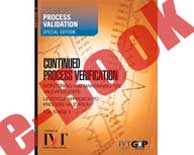- About IVT |
- Write for Us |
- Advertise |
- Partnerships |
- Careers |
- Contact

Continuing Process Verification
Jan 13, 2013 4:11 pm EST
This stage may be simply described as “maintaining validation” or “maintaining the validated state.” Maintenance activities of Stage 3 should be commensurate with the risk identified for the product and process. Assuming good development of the process, identification of potential variation, and control of same, the manufacturer must maintain the process under control over the entire product lifetime. This control must accommodate expected changes in materials, equipment, personnel, and other changes throughout the commercial life of the product based on risk analysis. Expectations for this stage involve an ongoing program to collect and analyze process data, including process trends, incoming materials, in-process material, and finished products. Data should be analyzed using statistical principles by trained personnel. Procedures defining trending and calculations, evaluation of inter-batch and intra-batch variation, evaluation of parameters and attributes, adjustment of monitoring levels based on the above and timely assessment of defect complaints, out-of-specification (OOS) investigations, deviations, yield variations, and other information are expected. Process improvement changes are expected based on review of process data. Facilities, utilities, and equipment must be maintained to ensure process control. The purpose of this process validation stage is to verify that the process is in a state of control and is performing consistently and in accordance with the process that was tested during the process qualification stage. Continuous process verification, or ongoing monitoring by means of process analytical technology (PAT), is desirable and highly recommended. Detection of deviations or excursions from the operation of the qualified process is essential to effectively perform continued process verification. This is done by collecting and analyzing process information in real-time, especially critical process parameter and critical product quality attribute data, to assess process performance and to make real-time process corrections, as required, to assure that a consistent product is produced from each manufacturing run. The 2004 FDA Process Analytical Technologies Guidance provides a basis for the strategies that support real-time adjustments to manufacturing processes to correct for input variability. The bases for continued process verification with respect to monitoring production output, performance of statistical analyses on processes, and establishment of statistical quality control criteria can be found in 21 CFR 211.100(a), 21 CFR 211.110(b), and 21 CFR 211.165(b), respectively.
This is Part III of IVT's special edition series on process validation. It covers best practices to ensure compliance and expert insight on monitoring and maintaining the validated state and Stage 3 of FDA's Lifecycle Approach to Process Validation.
Table of Contents
Case Study #3—Process Validation Failure of a Liquid Product Batch Size Increase—“Identical” Manufacturing Tanks
Paul L. Pluta
Compliance Case Study #5—Secondary Packages With Defective Glue Joints
D. Wylie McVay, Jr.
Dos and Don’ts of Control Charting—Part I
John McConnell, Brian K. Nunnally, and Bernard McGarvey
The Dos and Don’ts of Control Charting—Part II
John McConnell, Brian Nunnally, and Bernard McGarvey
GMP Monitoring—What, Why, Where, and How
Gamal Amer
Having It All
John McConnell, Brian K. Nunnally, and Bernard McGarvey
Like-For-Like Changes: Is Validation Testing Needed? Validation Case Study #7
Paul L. Pluta
Meeting Specifications is Not Good Enough—The Taguchi Loss Function
John McConnell, Brian K. Nunnally, and Bernard McGarvey
Process Modeling: A Powerful Weapon in the Fight to Reduce Variation—Part 1
John McConnell, Brian K. Nunnally, and Bernard McGarvey
Rational Revalidation
Hosam Aleem, Tim McCarthy, and Rodger Edwards
Substandard Data and Documentation Practices—Case Study #5
Paul L. Pluta and Timothy J. Fields
Understanding and Reducing Analytical Error—Why Good Science Requires Operational Excellence
John McConnell, Brian K. Nunnally, and Bernard McGarvey
Understanding the Process Nonconformity Concept—The Scientific Reason for Process Validation
Pramote Cholayudth
Using Probability Distributions to Make Decisions
David LeBlond
Variation—Past, Present, and Future
John McConnell, Brian K. Nunnally, and Bernard McGarvey
White Spots on Tablets—Compliance Case Study #8
Paul L. Pluta
This content is only available to IVT members. Get help maintaining your knowledge in Validation and Compliance best practices. Read More!
If you are already a member and you do not have access to this article, upgrade your membership. Need help? Read our FAQs.
Item Subjects:

